Wesson Oil Recipe for Beef Sukiyaki
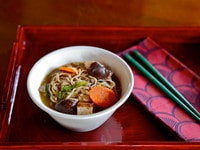
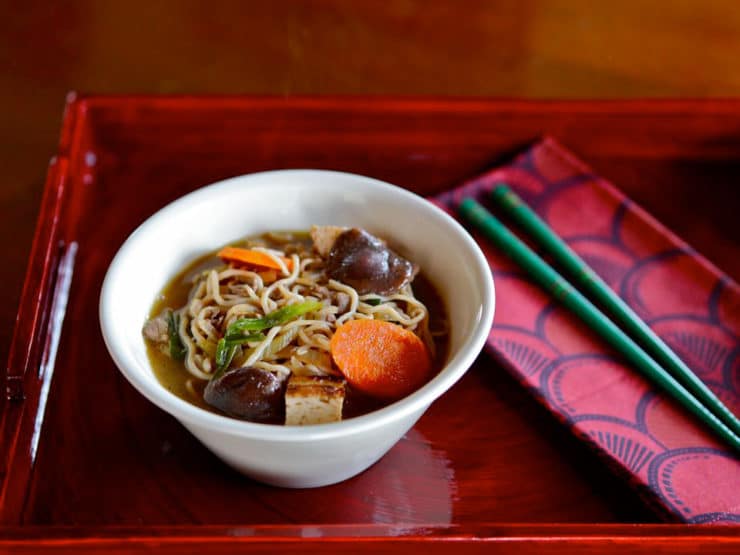
Asian grandmothers are often the gatekeepers of family recipes. More often than not, these beloved recipes are not written down; they are passed down verbally through the generations. Patricia Tanumihardja made it her mission to write down several of these family recipes in The Asian Grandmother's Cookbook, a beautiful collection of authentic recipes from Korean, Indian, Thai, Vietnamese, Japanese and Chinese kitchens. I first met author Patricia at a blogging conference a few years ago, then we met again through an organization called IACP. We are now working together in the IACP Food History Section, which I am chairing this year. I was thrilled when Pat sent me a copy of her cookbook. For many of the recipes, this is the first time they have ever been tested and written down. I was touched by the stories and intrigued by the flavors. This book is really special.
The weather has recently turned chilly here in Los Angeles. I wanted to make something hot and comforting to warm us up. A recipe for Japanese Beef and Vegetable Hot Pot, or sukiyaki, caught my eye. The recipe comes from a grandmother named Kimiye Hayashi. Kimiye's parents came to America from Hiroshima, making her second generation Japanese. She was born in Pueblo, Colorado in December 1922. When she was five years old the family moved to Southern California, where she spent the next 10 years on Terminal Island, a fishing community located in Los Angeles County. Kimiye describes the island as being "just like a Japanese village." Many Japanese lived there, including Kimiye's father, working for the French's and Van Camp fishing canneries. As you might imagine, fish made up a great part of her family's diet, along with rice and vegetables.
Just after high school, at age 18, Kimiye was happily married to Shibo Hayashi. The couple found themselves in the midst of tragedy the following year when Pearl Harbor was attacked. The FBI placed all of the Japanese men living on Terminal Island in detention centers, but luckily Kimiye and Shibo were able to escape to an abandoned farm in Torrance, CA along with Kimiye's four younger sisters and brothers. Eventually, the family was taken to the Rohwer War Relocation center in Arkansas where she gave birth to her first daughter. After one year, they were given permission to leave the camp. They traveled north to Michigan where they found work with Dutch farmers living in Imlay City.
When the war ended, the Hayashi family settled on their own farm in Michigan. In 1960 they relocated to Seattle, where Shibo found farm work in the suburbs. Kimiye took care of the house and their five children. She cooked both American and Japanese meals, including this Japanese Beef and Vegetable Hot Pot, which she would make with whatever vegetables were available. Kimiye took home economics and learned to cook a bit in high school, but she credits her kitchen skills to Japanese church-published cookbooks she collected over time.
We really enjoyed this hot pot, it was filling, comforting and healthy. We used shirataki noodles, which are low carb and low calorie. The broth is both savory and sweet; we used mirin, which has a natural sweetness to it. I prefer a more savory broth, so next time I will omit the sugar and use sake instead. I've marked the sugar as optional below. I loved the broiled tofu and the large amount of vegetables. The noodles used are gluten free, which is a bonus for people with food sensitivities. We stirred in some red pepper flakes to spice it up. It was such a treat on a cold evening.
This is just one of the fascinating stories and delicious recipes featured in The Asian Grandmother's Cookbook. It is not a kosher cookbook, however it is a fascinating look at family food stories and recipes. It's definitely worth reading, especially if you are a fan of Asian foods and flavors. To pick up your own copy, click here.
Recommended Products :
Heavy Cutting Board
Dutch Oven
Sheet Tray

We are a participant in the Amazon Services LLC Associates Program, an affiliate advertising program designed to provide a means for us to earn fees by linking to Amazon.com and affiliated sites. As an Amazon Associate I earn from qualifying purchases.
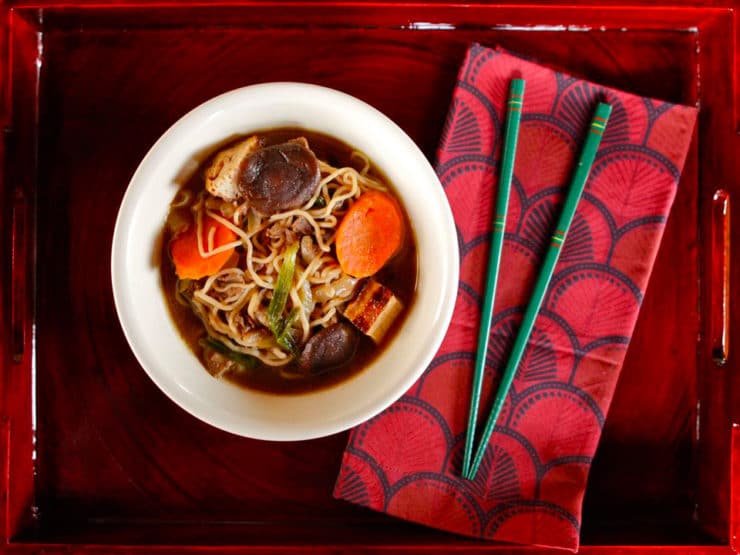
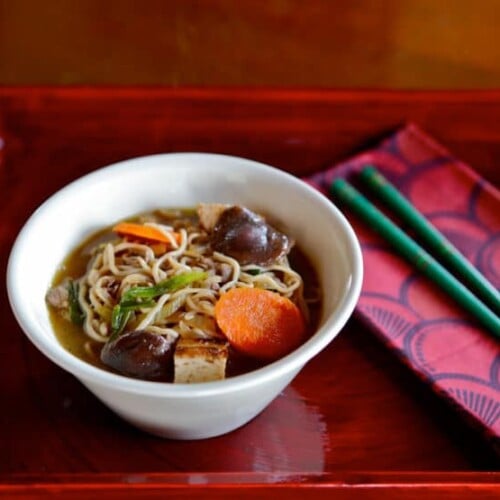
Japanese Beef and Vegetable Hot Pot (Sukiyaki)
Recipe for sukiyaki, a Japanese hot pot made with beef and vegetables. Healthy, gluten free comfort food from The Asian Grandmother's Cookbook.
PRINT RECIPE Email Me Recipes
Sauce Ingredients
- 1 cup chicken stock or dashi (use broth for gluten free)
- 1/2 cup Japanese soy sauce (use tamari for gluten free)
- 1/2 cup mirin or sake (use sake for a more savory broth)
- 1/4 cup sugar (optional)
Hot Pot Ingredients
- 4 oz shirataki or cellophane noodles
- Boiling water
- 2 tbsp vegetable oil, divided, plus more as needed
- 1 lb well-marbled tender beef*, sliced paper thin across the grain, then cut into bite-sized pieces
- 1 large yellow onion, halved and cut into thin crescents
- 1 cup fresh shiitake, enoki, or button mushrooms
- 2 medium carrots, peeled and cut into 1/4 inch diagonal slices
- 2 stalks celery, cut into 1/4 inch diagonal slices
- 5 green onions, white and green parts, cut into 2-inch diagonal lengths
- 9 oz broiled firm tofu, cut into 16 pieces
You will also need: 2 small heavy cutting boards, heat-proof bowl, colander, dutch oven or heavy bottomed pot, sheet tray, aluminum foil, nonstick cooking spray
- For a more savory (less sweet) broth, cut the sugar and use sake instead of mirin.
- If you are gluten-free, make sure all of your packaged products are certified GF.
- Pat has a great post on The Culinary Life discussing which ingredients are gluten-free and what can be subbed.
*The best cuts of beef for this recipe are sirloin tip, top sirloin, or tenderloin.
-
Broiled tofu can be found in some markets under the name yakitofu, but you can also make it at home fairly easily. If broiling tofu at home, you must first drain the water from your tofu. Sandwich it between two heavy cutting boards lined with paper towels. Place something heavy, like canned vegetables, on top of the top cutting board. Be sure that the cutting board and the weight on top of the tofu is at an even level. Press until the thickness of the tofu is 2/3 of the original thickness.

-
Set your oven to the broiler setting. Line a sheet tray with aluminum foil and spray with non-stick cooking spray. Spray your drained tofu with cooking spray as well and place onto the sheet tray.
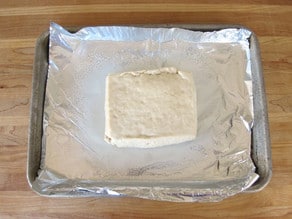
-
Broil for 10 minutes on the center rack of your oven, then flip and broil for an additional 8 minutes. Once cool cut into 16 1-inch cubes.
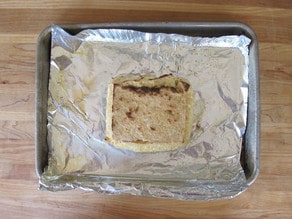
-
To make the sauce, mix together the chicken stock, soy sauce, mirin and sugar in a bowl. Taste and adjust seasonings if desired. Set aside.
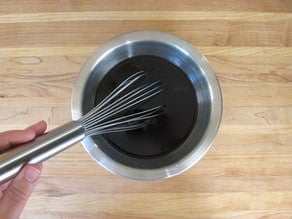
-
In a heatproof bowl, soak the noodles in boiling water for 1 minute.
Drain them in a colander, then rinse with cold water. Cut the noodles in half.
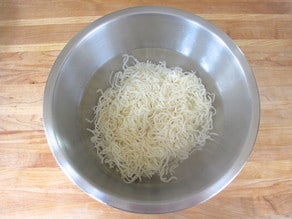
-
In a medium dutch oven or heavy-bottomed pot, heat 1 tbsp of the oil over high heat until it becomes runny and starts to shimmer. Add half of the the beef and stir until the meat is no longer pink, 2-3 minutes. Transfer to a plate. Repeat with the remaining beef, adding more oil if necessary.
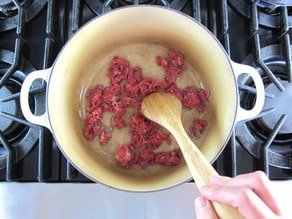
-
In the same Dutch oven, heat the remaining 1 tbsp oil over medium-high heat. Add the onion, mushrooms, carrots, and celery. Stir and cook until just tender, about 4-5 minutes.
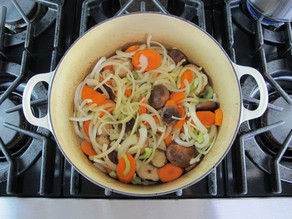
-
Add the green onions and stir until they turn bright green, about 30 seconds.
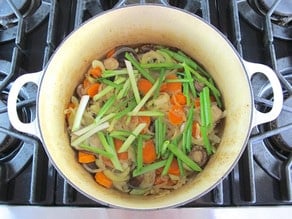
-
Add the sauce, noodled, cooked beef and tofu. Mix well and bring to a gentle boil over medium heat. Cook until all the ingredients are heated through and tender. Serve hot.
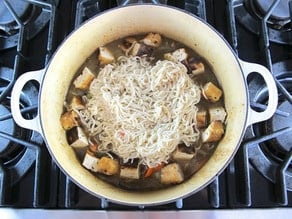
Nutrition Facts
Japanese Beef and Vegetable Hot Pot (Sukiyaki)
Amount Per Serving
Calories 212 Calories from Fat 54
% Daily Value*
Fat 6g 9%
Saturated Fat 3g 19%
Cholesterol 35mg 12%
Sodium 753mg 33%
Potassium 542mg 15%
Carbohydrates 21g 7%
Fiber 1g 4%
Sugar 13g 14%
Protein 17g 34%
Vitamin A 2665IU 53%
Vitamin C 3.6mg 4%
Calcium 33mg 3%
Iron 2.4mg 13%
* Percent Daily Values are based on a 2000 calorie diet.

tried this recipe?
Let us know in the comments!
Source: Tanumihardja, Patricia (2012). The Asian Grandmother's Cookbook. Sasquatch Books, Seattle, WA.
Nutritional information should be considered an estimate only; please consult a registered dietician, nutritionist, or your physician for specific health-related questions. Read more here. Please note that the recipe above is published using a recipe card plugin, with preexisting software which can auto-calculate metric measurements, as well as change the number of servings. Metric conversions and changes to the number of servings (resulting in different ingredient amounts) will only appear in the ingredient list, and are not changed within the step-by-step directions of the recipe.
albaradothaid1985.blogspot.com
Source: https://toriavey.com/toris-kitchen/japanese-beef-and-vegetable-hot-pot/

0 Response to "Wesson Oil Recipe for Beef Sukiyaki"
ارسال یک نظر